Employee Monitoring vs. Spying: What’s the Difference?
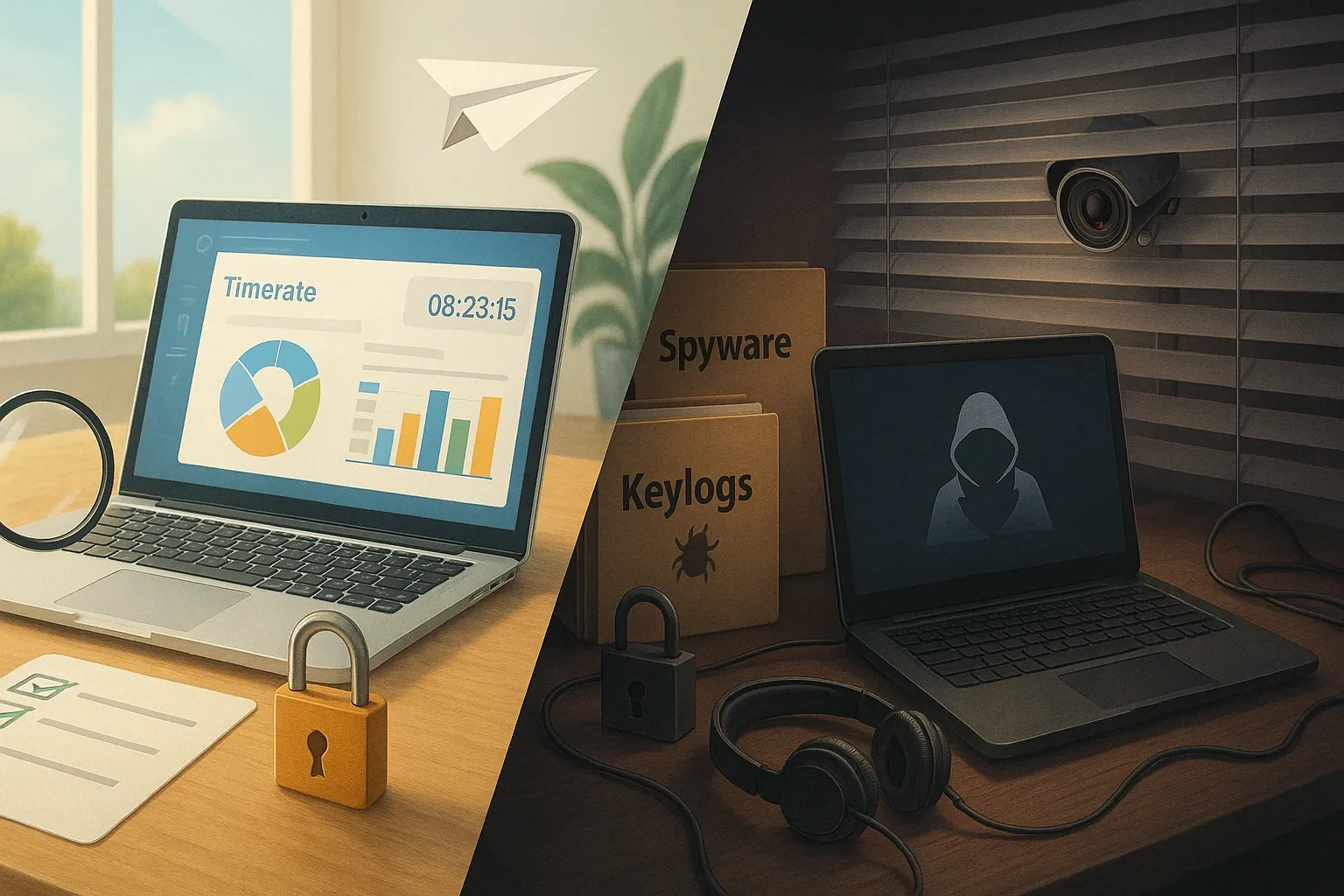
Key Summary:
-
Monitoring is transparent consent-based tracking, whereas spying is secretive and often violates privacy laws.
-
Invasive surveillance can violate privacy laws (e.g., ECPA, SCA, state privacy laws)
-
Ethical monitoring tools (e.g., Apploye) track employees with consent and can increase productivity by more than 28%.
Once, I was managing a remote team, and it was difficult to balance work and privacy. As a manager, I needed to track their progress. But I didn’t want them to feel like I was spying on them!
That’s when I realized the key difference between monitoring vs. spying.
Monitoring is about transparency. It tracks project progress, time use, and software activity. Employees know what is being monitored and why. So they feel supported rather than surveilled.
Spying, on the other hand, operates in secrecy. It includes secret monitoring, recording what people type, and reading messages without permission. This creates distrust and makes people feel unhappy.
In this article:
- What is monitoring and spying
- When employee monitoring becomes spying
- Legal risks of spying vs. monitoring
- Monitoring tools vs. spyware
- How to monitor employees in the right way
So, let’s start!
What Is Monitoring?
Monitoring means watching or keeping track of things to make sure they are safe and working well. People do this in different parts of life, like at home, at work, or in their daily routines.
The key thing is that monitoring is often done with consent. There is no watching someone secretly.
For example, parents monitor their children’s online activity. These apps can block bad content, limit screen time, and show where the child is.
In the same way, many workplaces use monitoring tools to check work hours, internet usage, or how much work gets done. Employers tell their employees about these tools. This ensures transparency and a positive work environment.
So, the important part of monitoring is trust. Monitoring with consent keeps things safe and helps without bothering anyone.
How to Monitor Employees Working from Home
What is Spying?
Spying is when someone secretly monitors people without their consent. Often, people do this to get personal information without permission.
Not only people but also companies, especially hackers, operate secretly, so others remain unaware of their monitoring.
Often, spying is done for negative purposes, like information theft and data breaches. No matter the reason, spying is a serious invasion of individual privacy and can make people feel unsafe.
For example, security cameras can be placed in hotel rooms or changing areas to record people. Keyloggers are another sneaky method. Hackers and cybercriminals often use them to steal sensitive information.
Even companies and websites can track your online activities without clear consent. The real problem with spying is that it takes away your right to privacy.
When Employee Monitoring Becomes Spying?

Employee monitoring software can help businesses stay productive. But when it gets too extreme, it starts to feel like spying.
And honestly, no one likes the feeling of being watched every second.
At first, tracking might seem harmless if the purpose is to use the company's resources wisely or to meet deadlines. Many time tracking software help managers see who’s completing their tasks on time.
But if employers start monitoring beyond working hours, it becomes spying.
Put yourself in an employee’s shoes. Would you feel motivated or anxious?
Most likely, the worst will happen. Too much monitoring can make people feel stressed. When this happens, more and more employees tend to quit their jobs.
So you see, instead of improving their performance, it can have the opposite effect.
That’s why companies need to find a balance. Monitoring should ensure employee productivity and security. When employees know why certain tracking tools are in place and how the data is used, they’re less likely to feel spied on.
For this reason, businesses need to be transparent about their company monitoring policies. Let them know what is being tracked, when, and why.
Another important thing to consider is fairness.
If employers monitor lower-level employees only while executives have freedom, it creates resentment. Everyone in the workplace should be held to the same standards.
Ultimately, when employee monitoring turns into spying, it does more harm than good.
So, instead of pushing employees to perform better, it pushes them away. Because how you track your employees says a lot about how much you trust them.
The Pros and Cons of Employee Monitoring
Balance monitoring with Apploye's transparent features
Legal Risks of Spying vs. Responsible Monitoring
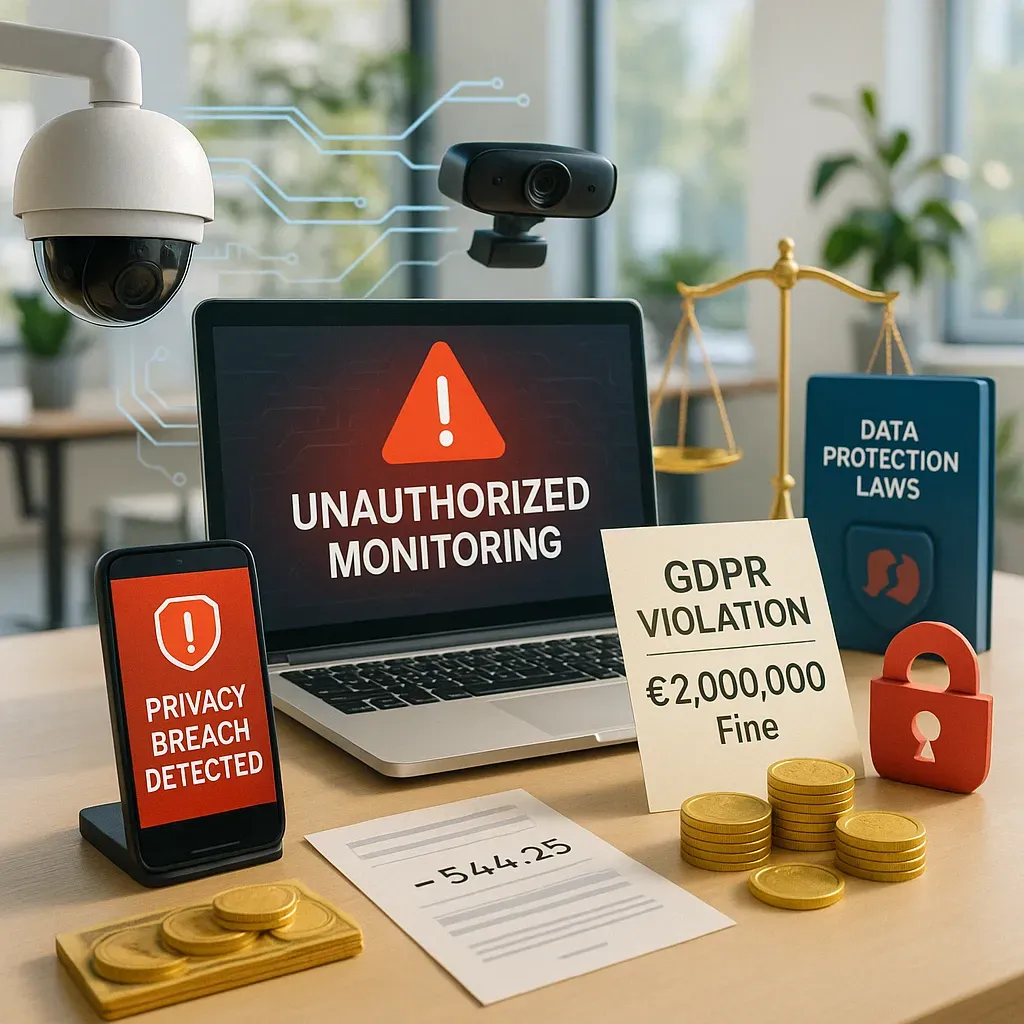
Over-monitoring employees can lead to legal consequences, especially if it breaks privacy rights and turns into spying.
Companies that use overly intrusive surveillance systems risk violating data protection laws and may face significant fines or legal action.
For example, in France, Amazon was fined $35 million for excessively intrusive monitoring of warehouse workers. CNIL found this system placed workers under constant surveillance and pressure. This violated EU privacy regulations.
Here are the laws to obey when monitoring employees:
Violations of Federal and State Privacy Laws
- Electronic Communications Privacy Act (ECPA): It's illegal to secretly listen to or read someone's emails, messages, or calls. Breaking this law can lead to big fines.
- Stored Communications Act (SCA): Employers can't look at their workers' saved data unless they have permission. If they do, they could be sued.
- State Privacy Laws: California and Illinois have rules about how businesses collect personal information. If companies break the rules, they can be fined.
Consent and Notification Requirements
- If you don't tell employees about monitoring when required (like in Connecticut or Delaware), you may face trouble.
- Also, if you watch what third parties, like email senders, do without permission, you could get into legal trouble. California and Illinois have some of the strictest regulations.
Unlawful Access to Personal Accounts
- Some states prohibit employers from requesting access to employees' private accounts (e.g., social media, personal emails).
- If additional monitoring software accidentally captures personal login credentials, it could lead to claims of unauthorized access.
Workplace Discrimination and Retaliation Claims
- Monitoring software tracks details like location, race, gender, or other protected groups. This could violate laws against discrimination, such as Title VII or the ADA.
- If companies use this data to take disciplinary actions or fire employees, they could be sued for unfair dismissal or retaliation.
Computer Crime and Spyware Violations
- Installing monitoring software on personal devices without consent can violate state anti-spyware laws. This is applicable in California and New York.
- Employers who exceed authorized access under the Computer Fraud and Abuse Act (CFAA) could face criminal charges.
Breach of Contract or Implied Employee Rights
- If an employer doesn't follow its company rules or breaks an employment contract regarding privacy, the employee can file for breach of contract.
- In some cases, courts have decided that too many surveillance practices can go against an employee's right to privacy.
Employee Monitoring Laws
Stay legally compliant with Apploye
Monitoring Tools vs. Spyware: Know What You’re Using
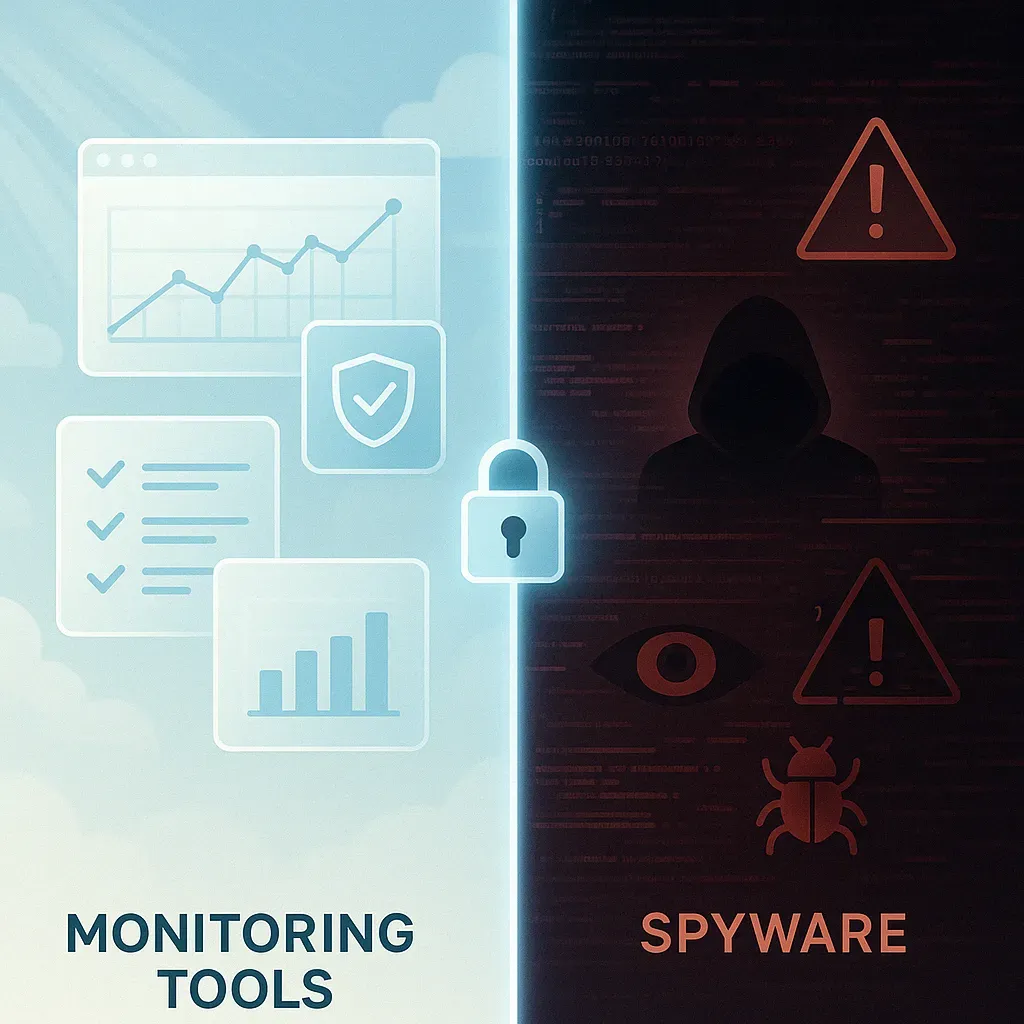
Monitoring tools help businesses track employee performance, increase workplace productivity, and detect insider threats.
On the other hand, spyware is invasive, unethical, and often illegal.
So, how do you draw the line between ethical monitoring and spying on employees in the workplace?
Let's break down the key features:
Ethical Productivity Monitoring Software
Recommended monitoring tools
Apploye
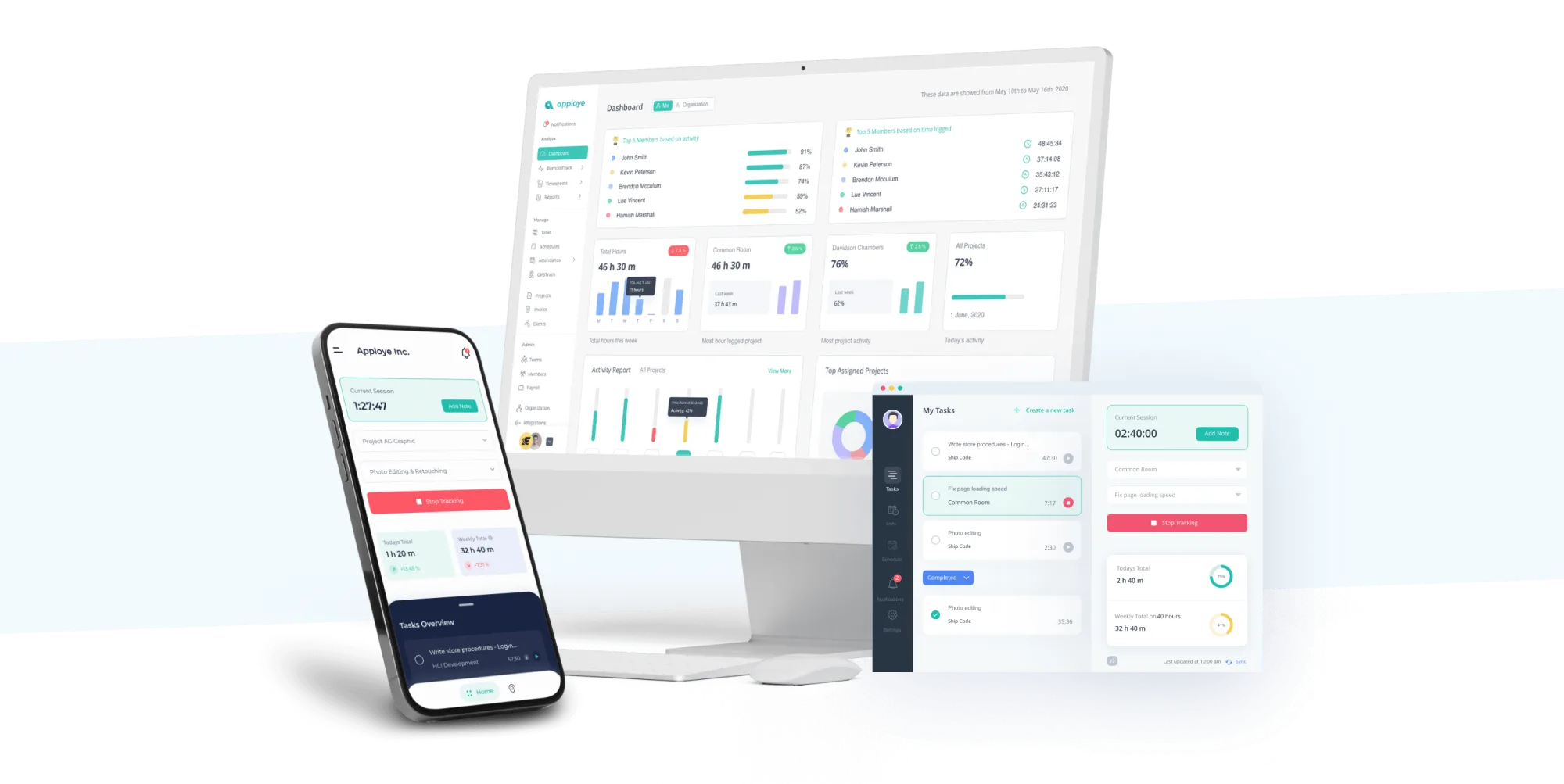
If you're looking for an all-in-one, ethical employee monitoring tool, Apploye is the perfect solution. Now, let's talk about what truly makes Apploye an ethical and efficient monitoring tool.
Unlike other rigid employee tracking systems, Apploye focuses on boosting productivity transparently and fairly. It helps both employers and employees understand their work habits and make an informed decision.
Real-time remote employee monitoring, project tracking, and task management features ensure projects stay on track without micromanaging their teams.
The software automatically tracks time with screenshots and even monitors application usage. These help business owners and managers identify workflow inefficiencies and improve team collaboration.
And guess what? Businesses that use Apploye have reported up to a 28% increase in productivity!
What makes Apploye even better is that it can integrate with other project management tools (e.g., Jira, Asana, Trello).
Overall, Apploye helps businesses stay organized, keeps employees accountable in a fair way, and makes work more efficient.
#1 Time Tracker App for desk, mobile & remote teams
Teramind
Teramind is also a great choice for ethical employee monitoring. The app prevents data loss as it protects important company information.
So, you can keep your business safe while making sure your employees stay productive.
Teramind records video sessions, tracks keystrokes, and monitors emails, websites, and app usage. This is useful for businesses that handle sensitive data and need higher levels of security measures.
Some monitoring tools can feel intrusive, but Teramind aims to be ethical. It provides transparency by allowing businesses to maintain operational compliance with company policies about what’s being observed.
Yes, Teramind may seem a bit pricey, but you get what you pay for. It offers more monitoring capabilities compared to other employee tracking tools.
Companies now also use data loss prevention (DLP) tools. These systems monitor employee activities through keystroke logging, network tracking, and artificial-intelligence-driven analysis. It also examines user behavior analytics and detects unusual activity.
Tools That Raised Red Flags
mSpy
mSpy is more of a surveillance tool than professional performance tracking software. Instead of helping employers manage productivity, it focuses almost entirely on monitoring every move employees make.
At first, mSpy seems like a regular form of employee monitoring. It provides real-time GPS tracking, keylogging, and social media monitoring. It even features stealth mode to track employee activities without them knowing.
It can also access texts, emails, and even monitor messaging apps like WhatsApp, Slack, and Microsoft Teams.
But is that the right way to monitor your employees?
Ethical monitoring tools inform employees about the tracking policies in place, whereas mSpy operates in stealth mode and tracks without consent.
The biggest technical issue is that to access mSpy’s full feature set, you need to root or jailbreak the target device. This can weaken device security and void warranties.
No legitimate business should have to compromise device integrity just to monitor employees.
FlexiSPY
FlexiSPY has several red flags that make me question its effectiveness and ethical implications. It lacks essential management features like productivity tracking, website filtering, and screen time control.
Employers can remotely activate a device’s microphone, take screenshots, and even control the webcam without the employee’s consent. This level of intrusion goes far beyond acceptable monitoring practices.
Without clear transparency and consent from employees, using such a tool could easily violate workplace privacy laws.
Another red flag is that employers can set up alerts for keywords, specific phone numbers, or location changes.
In this case, the user behaviour analytics is useless. Instead of providing insight into time spent on apps, it only logs when an app is launched or installed.
This lack of meaningful data makes it impossible for employers to measure productivity.
Remote access features like RemCam and RemVid are downright dangerous. Activating an employee’s camera without their knowledge could lead to severe legal issues.
Apploye: A monitoring tool that also builds trust
How to Monitor Employees the Right Way (Without Spying)
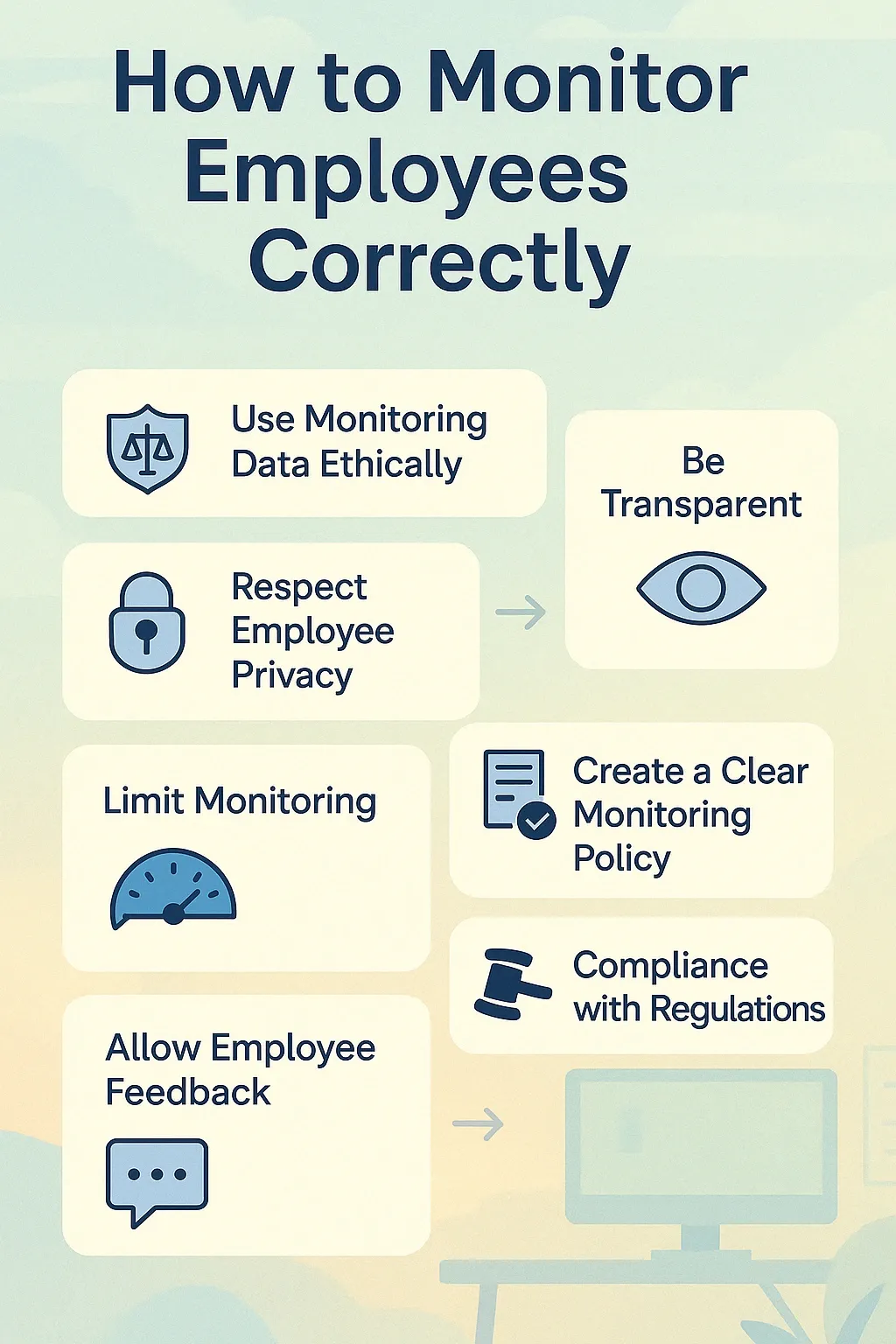
Effective employee monitoring software shouldn’t feel like spying. The following seven practices are the right way you monitor your employees without spying:
1. Use Monitoring Data Ethically
Research showed that 84% of employers tell their employees about monitoring. When companies are upfront, employees are more likely to accept it.
However, when monitoring is done secretly, employees feel stressed and start looking for new jobs. Nobody wants to feel like their boss is watching their every move.
So, the best way to use analytics from employee monitoring is to improve operational efficiency.
If data is only used to call out mistakes, employees will feel like they’re being watched just to get in trouble.
Instead, it should be used to guide improvements, make work smoother, and reward good employee performance.
2. Be Transparent
The best approach to employee monitoring is to be transparent. Explain why it’s necessary and how it helps the business.
Start by telling them the purpose. Is it to prevent security breaches? Increase productivity? Or to keep sensitive data safe?
Let them know what you’ll be checking for, and also, explain the possible outcomes.
A Gartner study. found that only 30% of employees were comfortable with email monitoring. But when companies explained why, that number jumped to over 50%.
3. Respect Employee Privacy
The University of Chicago Press Journal suggests focusing on efficiency over excessive surveillance.
There’s a fine line between responsible monitoring and spying on employees at work. You have to follow privacy laws, of course.
Around 79% of employees worry about data security when monitored. When you respect privacy, employees feel safe, and trust grows.
You should not track personal emails, GPS locations, or workplace monitoring without consent. Employees need to trust that their personal life is respected.
That’s why monitoring should only happen during work hours. Anything beyond that is overstepping.
4. Create a Clear Monitoring Policy
When you monitor your staff, it’s important to be transparent. You need a strong policy that explains everything. Plus, your policy should cover which company assets are monitored and the rules for using them.
You should also give them a chance to ask questions.
5. Limit monitoring Sometimes
According to Forbes, 23% of employees feel constantly watched. Whereas 30% of employees say they are okay with monitoring (as long as it's transparent and ethical).
If you monitor too much, it can feel like you're invading personal space, and honestly, no one likes that.
Setting a clear balance between monitoring personal and professional lives is also crucial. Look for circumstances where you can limit the monitoring. Avoid collecting personal data unless it’s necessary.
6. Compliance with Regulations
When it comes to best employee monitoring practices, you must be informed about the laws.
You must follow these regulations to avoid any legal trouble. Laws like HIPAA and GDPR require businesses to protect sensitive data.
Another thing to keep in mind is that laws change. Keeping up with these changes and adjusting your practices helps you avoid breaking the rules.
7. Allow Employee Feedback
Allow employee feedback about employee monitoring systems. Let them express themselves comfortably.
For that, you may create anonymous surveys, focus groups, or one-on-one meetings.
Address employee concerns as soon as you can. It keeps everything transparent and increases workforce morale. In this way, their engagement and activity levels will naturally follow.
Finding the Balance: Ethical Monitoring vs. Harmful Spying
Employees are your biggest asset, and spying on them is not even an option.
Successful office or remote employee monitoring is when employees feel empowered to do their best. Trust and transparency should always take priority over secrecy and control.
When employees know they are valued, they are more engaged, productive, and committed to success.
A positive company culture and human connection are essential for maintaining a healthy work environment.
Start building trust with Apploye's ethical monitoring
Frequently Asked Questions About Monitoring vs. Spying
What is the difference between monitoring and spying?
Monitoring is watching activities to keep things safe, follow rules, or check how well things are working. It is done clearly and fairly. Spying, on the other hand, is secretive and intrusive, often done without consent.
Is monitoring legal?
Yes, monitoring is legal when done with consent and following state laws. However, I’d still advise you to consult with an employment attorney before implementing any monitoring system. This will avoid potential adverse action from employees.
Can employers monitor employees?
Yes, employers can monitor employees, but they must comply with workplace privacy laws. Before monitoring, transparency and clear policies are essential. They can keep tabs on employees but should avoid crossing privacy boundaries.
How to tell if your work phone is being monitored?
If your work phone is being monitored, you may notice these signs:
- The battery drains faster than usual.
- The phone feels hot even when you’re not using it.
- You hear strange sounds during calls.
- The screen lights up by itself.
- You see apps you didn’t install.
- The phone is slower than normal.
What is considered spying on someone?
Spying on someone means watching, listening to, or collecting their personal information without them knowing or agreeing. This can include:
- Reading their private messages or emails
- Following them without telling them
- Using hidden cameras or microphones to record them
- Tracking their location with a device or app
Are companies spying on employees at home?
Some companies monitor working-from-home workers. They may use software to check when you log in and out and what websites you visit. It can also track how much you type or move your mouse, and if you are using work apps or doing something else.
How can you tell if your boss is monitoring your email or computer activity at work?
Your boss may be able to see what you do on your work computer, including emails, websites, and apps. Here are some signs:
- You see a software you didn’t install.
- Your computer runs slowly or acts strangely.
- You get told things that only someone reading your emails or watching your screen would know.
- You notice your internet history is gone or changed.
Can an employer spy on employees and then fire them for what they observe?
Yes, but only in some cases. Employers can watch what employees do at work, like checking emails, internet use, or using security cameras in the office. But they must follow privacy laws. If an employee breaks company rules and the employer sees it, the employee could be fired. However, employers can't watch private things without a good reason.
Is it legal to install surveillance software to spy on employees' activities on a work laptop?
Yes, it is usually legal for a company to install surveillance software on work and other company-owned devices. Employers are allowed to check what employees do on company devices. But the rules can be different in each country or state.
How do I know if my company is spying on me during work?
Your company might be spying on you if they track what you do on your computer or phone. They may install software that records your screen, checks websites you visit, or watches how long you work. Sometimes, they ask you to install apps that do this without clearly saying why.
What are some signs that reveal your boss is spying on you as you work from home?
Here are some signs your boss might be watching you while you work from home:
- Your computer has a new spyware program that you did not install
- Your boss knows things you only do on your computer
- Your webcam turns on by itself.
- You hear strange clicks or see your mouse moving on its own.
- Your internet feels slower than usual.
- You get sudden emails asking why you took a break or were away for a few minutes.
How common is it for corporations to spy on their employees?
According to a study by the American Management Association, 80% of big companies check how their workers use the internet, phone, and email.
What is the difference between surveillance and monitoring?
Surveillance is watching someone or something closely, usually for safety or to find problems. Monitoring is checking something often to make sure it is working well or going as planned.

